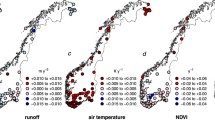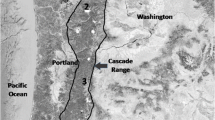Abstract
Changes in water pH and colour since the late 1980s were studied in 35 small boreal lakes of varying hydrological and landscape settings but similar climate and acid deposition. The data was collected during the autumnal overturn on the annual basis except in lake with weekly sampling during the ice-free period. In addition to the deposition data information about catchment soil types as well as local meteorological and hydrological conditions were used for the long-term data interpretation. The lakes are situated in a small area in southern Finland, 130 km north from Helsinki, where sulphate deposition declined by >60% in one decade since the mid-1980s. The results showed that water colour increased in most lakes while pH did not. In lakes dominated by surface runoff there was a distinct upward shift in colour, with an initial increase after the mid-1990s and a second increase in 2004. The first shift appeared when the sulphate deposition reached a level ca. 25% of that in 1988. However, the upward shift in colour also coincided with a change in hydrological conditions after several dry summers. In contrast, the second shift in colour clearly coincided with a switch in hydrology due to the abnormally wet summer of 2004 after severe drought in 2002–2003. Although the hydrological conditions indisputably had a key role in determining the annual variability in colour, a distinct negative relationship between acid deposition and water colour in 90% of the lakes strongly suggested that reduction in sulphate deposition fostered the leaching of coloured organic substances from the catchment soils. Increase in colour, in turn, strongly influenced lake water pH, and the present day higher organic matter concentrations seemingly depress pH values more than in the 1980s, before the reduction in acid deposition.








Similar content being viewed by others
References
Arvola L, Metsälä T-R, Similä A, Rask M (1990) Phyto- and zooplankton in relation to water pH and humic content in small lakes in southern Finland. Verh Int Ver Limnol 24:688–692
Arvola L, Kankaala P, Tulonen T, Ojala A (1996) Effects of phosphorus and allochthonous humic matter enrichment on the metabolic processes and community structure of plankton in a boreal lake. Can J Fish Aquat Res 53:1646–1662
Arvola L, Salonen K, Rask M (1999) Trophic interactions. In: Eloranta P, Keskitalo J (eds) Limnology of humic waters. Backhuys Publishers, Leiden, The Netherlands, pp 265–279
Arvola L, Räike A, Kortelainen P, Järvinen M (2004) Effect of climate and land use on TOC concentrations and load in Finnish rivers. Boreal Environ Res 9:381–387
Arvola L, Järvinen M, Hakala I (2006) Nutrient export from small boreal catchments: the influence of annual and seasonal hydrology. Verh Int Ver Limnol 29:2031–2034
Arvola L, George DG, Blenckner T, Dokulil M, Jennings E, Järvinen M, Livingstone D, Nöges P, Nöges T, Weyhenmeyer G (2010) The impact of changing climate on the thermal characteristics of lakes. In: George DG (ed) The impact of climate change on European lakes. Aquatic Ecology Series 4. Springer, pp 85–101
Eloranta P (1978) Light penetration in different types of lakes in central Finland. Holarct Ecol 1:362–366
Erlandsson M, Buffam I, Fölster J, Laudon H, Temnerud J, Weyhenmeyer GA, Bishop K (2008) Thirty-five years of synchrony in the organic matter concentration of Swedish rivers explained by variation in flow and sulphate. Glob Change Biol 14:1–8
Evans A Jr, Zelazny LW, Zipper CE (1988) Solution parameters influencing dissolved organic carbon levels in three forest soils. Soil Sci Soc Am J 52:1789–1792
Evans CD, Cullen JM, Alewell C, Kopácek J, Marchetto A, Moldan F, Prechtel A, Rogora M (2001) Recovery from acidification in European surface waters. Hydrol Earth Syst Sci 5:311–325
Evans CD, Monteith DT, Cooper DM (2005) Long-term increases in surface water dissolved organic carbon: observations, possible causes and environmental impacts. Environ Pollut 137:55–71
Freeman C, Evans CD, Monteith DT, Reynolds B, Fenner N (2001) Export of organic carbon from peat soils. Nature 412:785
Freeman C, Fenner N, Ostle NJ et al (2004) Export of organic carbon from peatlands under elevated carbon dioxide levels. Nature 430:195–198
Gilbert RO (1987) Statistical methods for environmental pollution monitoring. Van Nostrand Reinhold, New York
Huotari J, Ojala A, Peltomaa E, Pumpanen J, Hari P, Vesala T (2009) Temporal variations in surface water CO2 concentrations in a boreal lake based on high-frequency measurements. Boreal Environ Res 14:48–60
Järvinen M, Rask M, Ruuhijärvi J, Arvola L (2002) Temporal coherence in water temperature and chemistry under the ice of boreal lakes (Finland). Water Res 36:3949–3956
Jones RI (1998) Phytoplankton, primary production and nutrient cycling. In: Hessen DO, Tranvik L (eds) Aquatic humic substances: ecology and biogeochemistry. Ecological Studies 133. Springer, pp 145–175
Jones RI, Arvola L (1984) Light penetration and some related characteristics in small forest lakes in southern Finland. Verh Int Ver Limnol 22:811–816
Kalbitz K, Solinger S, Park JH, Michalzik B, Matzner E (2000) Controls of the dynamics of dissolved organic matter in soils: a review. Soil Sci 165:277–304
Kankaala P, Taipale S, Grey J, Sonninen E, Arvola L, Jones R (2006) Experimental δ13C evidence for a contribution of methane to pelagic food webs in lakes. Limnol Oceanogr 51:2821–2827
Krug EC, Frink CR (1983) Acid rain and acid soil: a new perspective. Science 221:520–525
Mannio J (2001) Recovery pattern from acidification of headwater lakes in Finland. Water Air Soil Pollut 130:1427–1432
Mattsson T, Kortelainen P, Räike A (2005) Export of DOM from boreal catchments: impacts of land use cover and climate. Biogeochemistry 76:373–394
Moldan F, Wright RF, Löfgren S, Forsius M, Ruoho-Airola T, Skjelkvåle BL (2001) Long-term changes in acidification and recovery at nine calibrated catchments in Norway, Sweden and Finland. Hydrol Earth Syst Sci 5:339–349
Monteith DT, Stoddard JL, Evans CD et al (2007) Dissolved organic carbon trends resulting from changes in atmospheric deposition chemistry. Nature 450:537–541
Nyberg K, Vuorenmaa J, Rask M, Mannio J, Raitaniemi J (2001) Patterns in water quality and fish status of some acidified lakes in southern Finland during a decade: recovery proceeding. Water Air Soil Pollut 130:1373–1378
Pennanen V, Frisk T (1984) A statistical model for conversion of absorbance measurements with significant iron interference into organic carbon in a polyhumic lake. Aqua Fenn 14:171–178
Pregitzer KS, Zak DR, Burton Aj, Ashby JA, MacDonald NW (2004) Chronic nitrate additions dramatically increase the export of carbon and nitrogen. Biogeochemistry 68:179–197
Rask M, Arvola L, Salonen K (1993) Effects of catchment deforestation and burning on the limnology of a small forest lake in southern Finland. Verh Int Ver Limnol 25:525–528
Rask M, Raitaniemi J, Mannio J, Vuorenmaa J, Nyberg K (1995) Losses and recoveries of fish populations in acidified lakes of southern Finland in the last decade. Water Air Soil Pollut 85:315–320
Roule N, Moore TR (2006) Environmental chemistry—browning the waters. Nature 444:283–284
Ruoho-Airola T, Syri S, Nordlund G (1998) Acid deposition trends at the Finnish integrated monitoring catchments in relation to emission reductions. Boreal Environ Res 3:205–219
Ruoho-Airola T, Anttila P, Salmi T (2004) Airborne sulphur and nitrogen in Finland—trends and exposure in relation to air transport sector. J Environ Monit 6:1–11
Salonen K, Arvola L, Rask M (1984) Autumnal and vernal circulation of small forest lakes in southern Finland. Verh Int Ver Limnol 22:103–107
Schindler DW (1998) A dim future for boreal waters and landscapes. Bioscience 48:157–164
Sen PK (1968) Estimates of the regression coefficient based on Kendall’s tau. J Am Stat Assoc 63:1379–1389
Skjelkvåle BL, Stoddard JL, Jeffries DS, Tørseth K, Høgåsen T, Bowman J, Mannio J, Monteith DT, Mosello R, Rogora M, Rzychon D, Veselý J, Wieting J, Wilander A, Worsztynowicz A (2005) Regional scale evidence for improvements in surface water chemistry 1990–2001. Environ Pollut 137:165–176
Stoddard JL, Jeffries DS, Lükewille A, Clair T, Dillon PJ, Driscoll CT, Forsius M, Johannessen M, Kahl JS, Kellogg JH, Kemp A, Mannio J, Monteith D, Murdoch P, Patrick S, Rebsdorf A, Skjelkvåle B-L, Stainton MP, Traaen T, van Dam H, Webster K, Wieting J, Wilander A (1999) Regional trends in aquatic recovery from acidification in North America and Europe. Nature 401:575–578
Stoddard JL, Karl JS, Deviney FA, DeWalle DR, Driscoll CT, Herlihy AT, Kellogg JH, Murdoch PS, Webb JR, Webster KE (2003) Response of surface water chemistry to the Clean Air Act Amendments of 1990. Report EPA 620/R-03/001. United States Environmental Protection Agency, North Carolina
Tammi J, Rask M, Vuorenmaa J, Lappalainen A, Vesala S (2005) Population responses of perch (Perca fluviatilis) and roach (Tutilus rutilus) to recovery from acidification in small Finnish lakes. Hydrolobiologia 528:107–122
Tipping E, Hurley MA (1988) A model of solid-solution interactions in acid organic soils, based on the complexation properties of humic substances. J Soil Sci 39:505–519
Tranvik IL, Jansson M (2002) Terrestrial export of organic carbon. Nature 415:861–862
Vance GF, David MB (1989) Effect of acid treatment on the leachate chemistry of a New England spodosol: importance of the B horizon on dissolved organic carbon retention. J Soil Sci Soc Am 53:1242–1247
Vuorenmaa J (2004) Long-term changes of acidifying deposition in Finland (1973–2000). Environ Pollut 128:351–362
Vuorenmaa J (2007) Recovery responses of acidified Finnish lakes under declining acid deposition. Helsinki, Finnish Environment Institute. 50 s. Monogr Boreal Environ Res 30:1–50
Vuorenmaa J, Forsius M (2008) Recovery of acidified Finnish lakes: trends, patterns and dependence of catchment characteristics. Hydrol Earth Syst Sci 12:465–478
Vuorenmaa J, Forsius M, Mannio J (2006) Increasing trends of total organic carbon concentrations in small forest lakes in Finland from 1987 to 2003. Sci Total Environ 365:47–65
Worral T, Burt TP (2007) Flux of dissolved organic carbon from UK rivers. Glob Biogeochem Cycl 21:GB1013. doi:10.1029/2006GB002709
Acknowledgments
The authors thank Riitta Ilola and Jaakko Vainionpää for the chemical analyses made at the lab of the Lammi Biological Station and all individuals and institutes who have made it possible to carry out the field work, technical support as well as the analyses. Also we want to thank Roger I. Jones for his comments and the English corrections.
Author information
Authors and Affiliations
Corresponding author
Rights and permissions
About this article
Cite this article
Arvola, L., Rask, M., Ruuhijärvi, J. et al. Long-term patterns in pH and colour in small acidic boreal lakes of varying hydrological and landscape settings. Biogeochemistry 101, 269–279 (2010). https://doi.org/10.1007/s10533-010-9473-y
Received:
Accepted:
Published:
Issue Date:
DOI: https://doi.org/10.1007/s10533-010-9473-y




